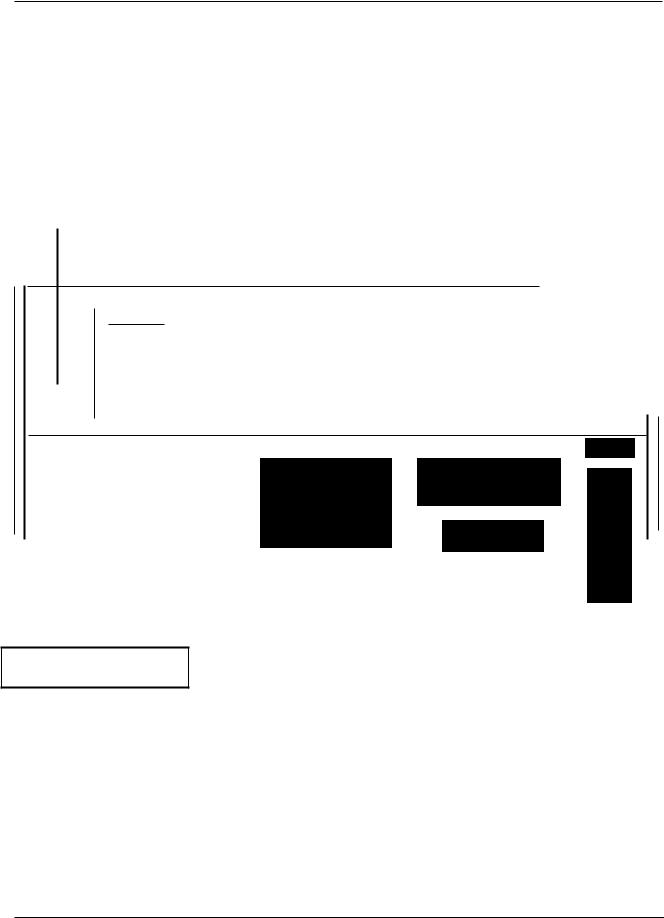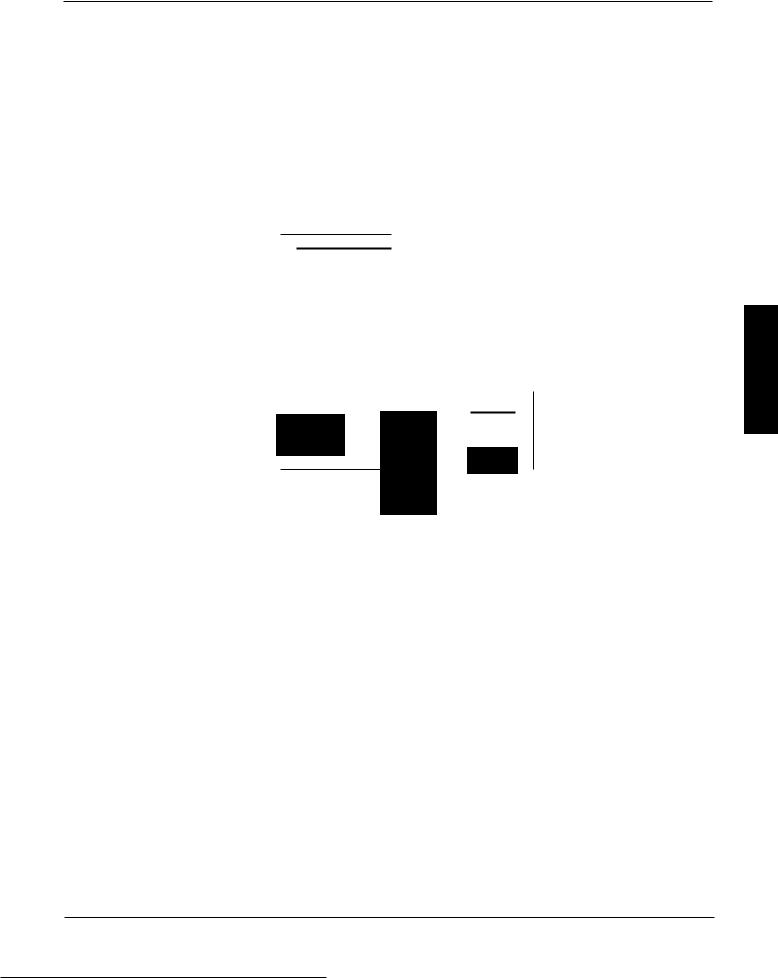Valleylab Force FX-C User manual
SERVICE MANUAL
Force FXTM-C
Electrosurgical Generator
with Instant Response™ Technology
Service Manual
Force FXTM-C Electrosurgical Generator
with Instant Response™ Technology

Preface
This manual and the equipment it describes are for use only by qualified medical professionals trained in the particular technique and surgical procedure to be performed. It is intended as a guide for servicing the Valleylab Force FXTM_C Electrosurgical Generator only. Additional information about using the generator is available in the Force FXTM-C
Electrosurgical Generator User's Guide.
Equipment covered in this manual:
Valleylab Force FX™-C Electrosurgical Generator vvith Instant Response™ Technology-
110-120 V ~ Nominal, 220-240 V ~ Nominal (auto selected)
The Force FX-C Electrosurgical Generator Service Manual consists of h-vo parts-the text (part 1 of 2) and a Schematics Supplement (part 2 of 2) which contains the schematics.
Valleylab Part Number: 945 103 064 (1 of 2)
Effective Date: September 2000
Patent Information: Protected by U.S. Pat. Nos. 4,416,276; 4,416,277; 4,658,820; 5,599,344; and 5,628,745.
Trademark Acknowledgments:
CUSATM, CUSA EXceFM, Force GSUTM, PolyHesiveT!l.1, REMTM, CEMTM, Force ArgonTM, Force FXTM, and Instant Response™ are trademarks of Valleylab; Teflon® is a registered trademark of E.I. DuPont de Nemours and Co., Inc.
Manufactured by:
Valleylab
Boulder, Colorado 80301-3299 USA
For information call:
1-800-255-8522/1-303-530-2300
Made in USA Printed in USA
©1999, 2000 Valleylab All rights reserved.
ii |
Force F)(TM -C Service Manual |

Conventions Used in this Guide
Warning
"'Important
Indicates an operating tip or maintenance suggestion.
Indicates a potentially hazardous situation which, if not avoided, could result in death or serious injury.
Indicates a hazardous situation which, if not avoided, may result in minor or moderate injury.
Notice
Indicates a hazard which may result in product damage.
Force FXTM-C Service Manual |
iii |

Table of Contents
Preface |
ji |
|
Conventions Used in this Guide |
iii |
|
List of Figures x |
|
|
Section 1. |
Introduction |
|
|
||||
General Description |
1·2 |
|
|
|
|
||
List of Components |
1·3 |
|
|
|
|
||
Service Personnel Safety |
1·3 |
|
|
||||
General |
1·3 |
|
|
|
|
|
|
Fire/Explosion Hazards |
1·4 |
|
|||||
Electric Shock Hazards |
1-5 |
|
|||||
Servicing |
1-5 |
|
|
|
|
|
|
Calibration |
1·6 |
|
|
|
|
||
Cleaning |
1·6 |
|
|
|
|
|
|
Section 2. Controls, Indicators, and Receptacles |
|||||||
Front Panel |
2·2 |
|
|
|
|
|
|
Bipolar Controls |
2·3 |
|
|
|
|
||
Bipolar Instrument Receptacle |
2·4 |
|
|||||
Monopolar Cut Controls |
2·5 |
|
|
||||
Monopolar Coag Controls |
|
2·6 |
|
|
|||
Monopolar Instrument Receptacles |
2·7 |
||||||
REM Alarm Indicator |
2·8 |
|
|
|
|||
Rear Panel |
2·9 |
|
|
|
|
|
|
Footswitch Receptacles |
2·10 |
|
|
||||
Monopolar Footswitch Receptacles 2·10 |
|||||||
Bipolar Footswitch Receptacle |
2·10 |
||||||
Power Entry Module |
2·11 |
|
|
|
|||
Activation Tone Volume Control |
2·11 |
||||||
Option Panel |
2·12 |
|
|
|
|
|
|
Section 3. |
Technical Specifications |
||||||
Performance Characteristics |
3·1 |
|
|||||
General |
3-1 |
|
|
|
|
|
|
Dimensions and Weight |
3·2 |
|
|||||
Operating Parameters |
|
3·2 |
|
|
|||
Transport and Storage |
3·2 |
|
|||||
Duty Cycle |
3-3 |
|
|
|
|
|
|
Internal Memory |
3·3 |
|
|
|
|||
Audio Volume |
3-3 |
|
|
|
|
||
IV |
Force FXTM·C Service Manual |

REM Contact Quality Monitor |
3-4 |
|
|
|
|||
Serial Port |
3-5 |
|
|
|
|
|
|
RF Activation Port |
3-5 |
|
|
|
|
|
|
Expansion Port |
3-5 |
|
|
|
|
|
|
Low Frequency (50-60 Hz) Leakage Current |
3-5 |
|
|
||||
High Frequency (RF) Leakage Current 3-6 |
|
|
|
||||
Input Power |
3-6 |
|
|
|
|
|
|
Standards and IEC Classifications |
3-7 |
|
|
|
|||
Class I Equipment(IEC 601-1) |
3-7 |
|
|
|
|||
Type CF Equipment (IEC 601-1)/Defibriliator Proof |
3-7 |
|
|||||
Drip Proof (IEC 601-2-2) |
3-7 |
|
|
|
|
||
Electromagnetic Interference 3-8 |
|
|
|
||||
Electromagnetic Compatibility (IEC 601-1-2 and IEC 601-2-2) |
3-8 |
||||||
Voltage Transients (Emergency Generator Mains Transfer) |
3-8 |
||||||
Output Characteristics |
3-9 |
|
|
|
|
|
|
Maximum Output for Bipolar and Monopolar Modes |
3-9 |
|
|||||
Maximum Output for Ultrasonic Electrosurgery |
3-9 |
|
|
||||
Available Power Settings in Watts 3-10 |
|
|
|
||||
Output Waveforms 3-11 |
|
|
|
|
|
||
Output Power vs. Resistance Graphs |
3-13 |
|
|
|
|||
Bipolar Graphs |
3-13 |
|
|
|
|
|
|
Monopolar Cut Graphs |
3·15 |
|
|
|
|
||
Monopolar Coag Graphs |
3-16 |
|
|
|
|
||
Sec"lion 4. Principles of Operation
Block Diagram |
4-2 |
|
|
|
|
|
Functional Overview |
4-3 |
|
|
|
|
|
Instant Response Technology 4·3 |
|
|
||||
Ultrasonic Electrosurgery |
4-3 |
|
|
|||
Simultaneous Coag |
4·3 |
|
|
|
||
REM Contact Quality Monitoring System |
4-4 |
|||||
Control Board |
4-5 |
|
|
|
|
|
Microcontrollers 4-5 |
|
|
|
|||
Main Microcontroller |
4-5 |
|
|
|
||
Feedback Microcontroller |
4-6 |
|
|
|||
Shared RAM |
|
4-7 |
|
|
|
|
I/O Expansion |
4-7 |
|
|
|
|
|
Keyboard Interface and Activation Inputs |
4-7 |
|||||
Power Supply Supervisor Circuit |
4-8 |
|
||||
AID and D/A Conversion |
4-8 |
|
|
|||
Waveform Generation (T_ON ASIC) |
4-8 |
|
||||
T_ON Average Check |
4-9 |
|
|
|
||
Audio Alarm |
|
4-9 |
|
|
|
|
Force FXTM-C Service Manual |
v |

Serial Interface |
4-9 |
|
|
|
|
Dosage Error Algorithm |
4-10 |
||||
Instant Response Algorithm |
4-11 |
||||
Front Panel |
4-12 |
|
|
|
|
Membrane Keyboard |
4-12 |
|
|||
Power Switch |
4-12 |
|
|
|
|
REM Connector/Switch |
4-12 |
||||
CEM Mechanism Switch |
4-12 |
||||
Display Board |
4-13 |
|
|
|
|
RF Indicator Lamps |
4-13 |
|
|||
REM Indicators |
4-13 |
|
|
||
LED and Seven-Segment Display Drivers 4-13 |
|||||
CEM Switch Circuit |
4-14 |
|
|||
Mode Selection and Power Control Switches 4-14 |
|||||
Footswitch Board |
4-15 |
|
|
|
|
Footswitch Decode Circuit |
|
4-15 |
|||
Audio Circuit |
4-16 |
|
|
|
|
Power Supply/RF Board |
4-17 |
|
|||
Power Supply/RF Board Interfaces 4-18 |
|||||
High Voltage Power Supply |
4-18 |
||||
Low Voltage Power Supply |
4-21 |
||||
RF Output Stage 4-21 |
|
|
|||
Spark Control Circuit |
4-24 |
|
|||
RF Leakage Reduction Circuit 4-25 |
|||||
REM Circuit 4-25 |
|
|
|
||
IsoBloc Circuit |
4-25 |
|
|
|
|
Temperature Sense Circuits |
4-26 |
||||
Section 5. Setup, Tests, and Adjustments
Setting Up the Generator |
5-2 |
|
|
|
Connections for Bipolar or Macrobipolar Surgery 5-4 |
||||
Setting the Bipolar Output |
5-5 |
|
|
|
Connections for Monopolar Surgery |
5-6 |
|||
Selecting Cut and Coag Modes 5-8 |
|
|
||
Simultaneous Coag |
5-8 |
|
|
|
Using Two Generators Simultaneously |
5-9 |
|||
Connecting the CUSA Handpiece with CEM Nosecone 5-10 |
||||
Setting the Output Power |
5-11 |
|
|
|
Simultaneous Coag with a CUSA System |
5-11 |
|||
Changing the Mode |
5-11 |
|
|
|
Changing the Power Setting |
5-11 |
|
|
|
Activating the Surgical Instrument |
5-12 |
|
||
vi |
Force F)(TM-C Service Manual |

Periodic Safety Check |
5-13 |
|
|
|
|
|
Recommended Test Equipment |
5-13 |
|
||||
Inspecting the Generator and Accessories |
5-14 |
|||||
Inspecting the Internal Components |
5-15 |
|
||||
Testing the Generator |
5-16 |
|
|
|
||
Verifying REM Function |
5-17 |
|
|
|
||
Confirming Outputs |
|
5-17 |
|
|
|
|
Check the Output for the Cut Modes |
5-19 |
|
||||
Check the Output for the Coag Modes |
5-20 |
|||||
Checking Low Frequency Leakage Current |
5-21 |
|||||
Checking High Frequency Leakage Current |
5-23 |
|||||
Calibrating the Force FX-C Generator |
5-24 |
|
||||
Preparing for Calibration |
5-25 |
|
|
|
||
Entering Calibration Mode |
5-25 |
|
|
|
||
Exiting Calibration Mode |
5-26 |
|
|
|
||
Verify the Force FX-C Generator Data |
5-26 |
|
||||
Adjust the Calendar |
|
5-27 |
|
|
|
|
Adjust the Clock |
5-28 |
|
|
|
|
|
Check and Adjust the REM Oscillator Frequency and Impedance 5-29 |
||||||
Check and Adjust the Current Sense Gain |
5-30 |
|||||
Check and Adjust the Voltage Sense Gain |
5-32 |
|||||
Check and Adjust the Reactance Gain |
5-34 |
|||||
Check and Adjust the ECON Factor |
|
5-36 |
|
|||
Using the RS-232 Serial Port |
5-40 |
|
|
|
||
Establish the Communications Link |
5-40 |
|
||||
Enter the Commands |
5-41 |
|
|
|
||
Disconnect the Computer from the Generator 5-44
Section 6. Troubleshooting
Inspecting the Generator |
6-1 |
|
Inspecting the Receptacles |
6-2 |
|
Inspecting the Internal Components 6-3 |
||
Correcting Malfunctions |
6-4 |
|
Responding to System Alarms |
6-10 |
|
Correcting IC U3 Malfunctions |
6-20 |
|
Correcting IC U6 Malfunctions |
6-22 |
|
Correcting T__ON ASIC Malfunctions 6-24
Correcting Battery-Backed RAM Malfunctions 6-26
Force FXTM-C Service Manual |
vii |

Section 7. Replacement Procedures
Interconnect Diagram |
7-2 |
|
|
|
|
|
|
|
|
|
Battery Replacement |
7-3 |
|
|
|
|
|
|
|
|
|
Control Board Replacement |
7-4 |
|
|
|
|
|
|
|||
Display Board Replacement |
7·5 |
|
|
|
|
|
|
|||
Remove the Display Board |
7·5 |
|
|
|
|
|
||||
Install the Display Board |
7-6 |
|
|
|
|
|
|
|||
Display Board Seven-Segment LED Replacement |
|
7-7 |
|
|||||||
Fan Replacement |
7·8 |
|
|
|
|
|
|
|
|
|
Footswitch Board Replacement |
7-8 |
|
|
|
|
|
||||
Front Panel Replacement |
7-9 |
|
|
|
|
|
|
|
||
Remove the Front Panel Assembly |
|
7-9 |
|
|
|
|||||
Remove and Reinsta" the Front Panel Components |
7·9 |
|||||||||
Insta" the Front Panel Assembly |
7·10 |
|
|
|
||||||
Front Panel REM Module Replacement |
7-11 |
|
|
|
||||||
Front Panel Power Switch Replacement |
|
7-12 |
|
|
|
|||||
Fuse Replacement |
7-13 |
|
|
|
|
|
|
|
|
|
Replacing Fuses in the Fuse Drawer |
7·13 |
|
|
|
||||||
Replacing the Fuse on the Power Supply/RF Board |
7-14 |
|||||||||
Left Front Heat Sink and Component Replacement |
7·15 |
|
||||||||
Remove the Left Front Heat Sink |
7-15 |
|
|
|
||||||
Replace Left Front Heat Sink Components |
7-16 |
|
||||||||
Install the Left Front Heat Sink |
7·16 |
|
|
|
||||||
Left Rear Heat Sink and Component Replacement |
7-17 |
|
||||||||
Remove the Left Rear Heat Sink |
7·17 |
|
|
|
||||||
Replace Left Rear Heat Sink Components |
7-18 |
|
||||||||
Install the Left Rear Heat Sink |
7-19 |
|
|
|
|
|||||
Right Heat Sink and Component Replacement |
7·20 |
|
||||||||
Remove the Right Heat Sink |
7-20 |
|
|
|
|
|||||
Replace Right Heat Sink Components |
7-21 |
|
|
|||||||
Install the Right Heat Sink |
7·22 |
|
|
|
|
|
||||
Low Voltage Power Supply Replacement |
7·23 |
|
|
|
||||||
Remove the Low Voltage Power Supply 7·23 |
|
|
||||||||
Install the Low Voltage Power Supply |
7-24 |
|
|
|||||||
Power Entry Module Replacement |
7-25 |
|
|
|
|
|||||
Remove the Power Entry Module |
7·25 |
|
|
|
||||||
Install the Power Entry Module |
7-26 |
|
|
|
||||||
viii |
Force F)(TM-C Service Manual |

Power Supply/RF Board Replacement 7-27 |
|
Remove the Power Supply/RF Board Assembly |
7-27 |
Remove Components from the Old Board 7-28 |
|
Install Components on the New Board 7-29 |
|
Install the Power Supply/RF Board Assembly |
7-30 |
Section 8. Repair Policy and Procedures
Responsibility of the Manufacturer |
8-1 |
|
Returning the Generator for Service |
8-2 |
|
Obtain a Return Authorization Number 8-2 |
||
Clean the generator |
8-2 |
|
Ship the generator |
8-3 |
|
Returning Circuit Boards |
8-3 |
|
Service Centers 8-4 |
|
|
Section 9. |
Service Parts |
|
||
Ordering Replacement Parts |
9-1 |
|
||
Generator Assembly |
9-2 |
|
|
|
Parts List |
9-4 |
|
|
|
Front Panel Assembly |
9-6 |
|
|
|
Parts List |
9-8 |
|
|
|
Control Board Components |
9-9 |
|
||
Display Board Components |
9-10 |
|
||
Footswitch Board Components 9-11 |
||||
Power Supply/RF Board Assembly |
9-14 |
|||
Parts List |
9-16 |
|
|
|
Power Supply/RF Board Components |
9-18 |
|||
Appendix A. Warranty
Appendix B. Board Drawings and Schematics
Force FXTM-C Service Manual |
ix |

List of Figures
Figure 3-1. |
Output power versus impedance for the Precise bipolar mode |
3-13 |
||
Figure 3-2. |
Output power versus impedance for the Standard bipolar mode |
3-14 |
||
Figure 3-3. |
Output power versus impedance for the Macrobipolar mode 3-14 |
|||
Figure 3-4. |
Output power versus impedance for the Low cut mode |
3-15 |
|
|
Figure 3-5. |
Output power versus impedance for the Pure cut mode |
3-15 |
|
|
Figure 3-6. |
Output power versus impedance for the Blend cut mode |
3-16 |
|
|
Figure 3-7. |
Output power versus impedance for the Desiccate coag mode |
3-16 |
||
Figure 3-8. |
Output power versus impedance for the LCF Fulgurate |
|
|
|
|
coag mode |
3-17 |
|
|
Figure 3-9. |
Output power versus impedance for the Spray coag mode 3-17 |
|||
Figure 3-10. |
Output power versus impedance for the Fulgurate coag mode |
3-18 |
||
Figure 5-1. |
Bipolar or macrobipolar connections-footswitch activation and a |
|||
|
handswitching or footswitching instrument 5-4 |
|
|
|
Figure 5-2. |
Bipolar or macrobipolar connection-handswitching |
|
|
|
|
instrument |
5-5 |
|
|
Figure 5-3. |
Monopolar connection-footswitch activation and a footswitching |
|||
|
or handswitching instrument using Monopolar 1 Footswitch |
|
||
|
receptacle and Monopolar 1/CEM Instrument receptacle |
5-6 |
|
|
Figure 5-4. |
Monopolar connection-footswitch activation and a footswitching |
|||
|
or handswitching instrument using Monopolar 2 Footswitch |
|
||
|
receptacle and Monopolar 2 Instrument receptacle 5-7 |
|
|
|
Figure 5-5. Monopolar connection-handswitch activation and a monopolar handswitching instrument using either Monopolar Instrument receptacle 5-7
Figure 5-6. Connections for simultaneous coag-two handswitching instruments 5-9
Figure 5-7. |
Connection for simultaneous coag using two footswitching |
||
|
instruments 5-9 |
|
|
Figure 5-8. |
Connections for combined monopolar/ultrasonic surgery 5-10 |
||
Figure 5-9. |
Leakage current test circuit per IEC 60601-1 5-21 |
|
|
Figure 7-1. |
Removing and disconnecting the power switch 7-12 |
||
Figure 9-1. |
Generator Assembly Illustrated Parts |
9-2 |
|
Figure 9-2. |
Generator Assembly Illustrated Parts-continued |
9-3 |
|
Figure 9-3. |
Front Panel Assembly Illustrated Parts |
9-6 |
|
Figure 9-4. |
Front Panel Assembly Illustrated Parts-continued |
9-7 |
|
x |
Force F)(TM-C Service Manual |

Figure 9-5. |
Power Supply/RF Board Assembly Illustrated Parts 9-14 |
Figure 9-6. |
Power Supply/RF Board Assembly Illustrated |
|
Parts-continued 9-15 |
Schematic Supplement
Schematic 1. |
Control board layout 8-1 |
|
|
|
Schematic 2. |
Control board schematic, page 1 of 3 |
8-2 |
|
|
Schematic 3. |
Control board schematic, page 2 of 3 |
8-3 |
|
|
Schematic 4. |
Control board schematic, page 3 of 3 |
8-4 |
|
|
Schematic 5. |
Display board, page 1 of 4 8-5 |
|
|
|
Schematic 6. |
Display board schematic, page 2 of 4 |
8-6 |
|
|
Schematic 7. |
Display board schematic, page 3 of 4 |
8-7 |
|
|
Schematic 8. |
Display board schematic, page 4 of 4 |
8-8 |
|
|
Schematic 9. |
Footswitch board, page 1 of 3 8-9 |
|
|
|
Schematic 10. |
Footswitch board schematic, page 2 of 3 |
8-10 |
|
|
Schematic 11. |
Footswitch board schematic, page 3 of 3 |
8-11 |
|
|
Schematic 12. |
Power Supply/RF board, page 1 of 8 |
8-12 |
|
|
Schematic 13. |
Power Supply/RF board schematic. page 2 of 8 |
8-13 |
||
Schematic 14. |
Power Supply/RF board schematic, page 3 of 8 |
8-14 |
||
Schematic 15. |
Power Supply/RF board schematic, page 4 of 8 |
8-15 |
||
Schematic 16. |
Power Supply/RF board schematic, page 5 of 8 |
8-16 |
||
Schematic 17. |
Power Supply/RF board schematic, page 6 of 8 |
8-17 |
||
Schematic 18. |
Power Supply/RF board schematic. page 7 of 8 |
8-18 |
||
Schematic 19. |
Power Supply/RF board schematic, page 8 of 8 |
8-19 |
||
Force F)(TM-C Service Manual |
xi |

Notes
xii |
Force FXTM-C Service Manual |
|

Introduction
This manual provides instructions for servicing the Valleylab Force FX-C Electrosurgical Generator with Instant Response Technology. This section introduces the features and components of the generator and reviews the precautions associated with generator repair.
Force F)(TIfLC Service Manual |
1-1 |
...........................................",.,.,.,"""'"'',,,,,,,,,,,,,,,,,,,,,,,,,,,,,,,,,,,,,,,,,,,,,,,,,,,,,,,,,,.,.,,,.,.,.,.,.,,,.,.,.,.,.,.'''''''''''''''''''''....~~~-----.''''''''''''''"'''~-~~-~~~-''''''''- ---------------------"

General Description
General Description
The Force FX-C generator is an isolated output electrosurgical generator that provides the appropriate power for cutting, desiccating, and fulgurating tissue during bipolar and monopolar surgery.
Features include:
•Instant Response Technology
•Three bipolar modes: precise (low), standard (medium), and macro (macrobipolar)
•Three monopolar cut modes: low, pure, and blend
•Three monopolar coag modes: desiccate (low), fulgurate (medium), and spray (high)
•Support for simultaneous coagulation
•The VaUeylab REM Contact Quality Monitoring System
•Support for ultrasonic electrosurgery using the Valleylab
CUSA System 200 or CUSA EXcel and a CUSA handpiece with a CUSA electrosurgical module (CEM) nosecone
•Handswitch or footswitch activation
•Recall of most recently used mode and power settings
•Adjustable activation tone volume
•An RF activation port, R5-232 serial port, and expansion port
•Force GSU system and Force Argon system compatibility.
1-2 |
Force F)(TM-C Service Manual |

List of Components
List of Components
The Force FX-C generator is a self-contained unit, consisting of a main enclosure (cover and base) and power cord. The main components of the generator are the following:
•Front panel components-power switch; controls for setting the modes and output power; a button for recalling the pmver settings and modes that were used last; receptacles for connecting electrosurgical accessories; and indicators that alert you to the current settings and patient return electrode status.
•Rear p,mel components-volume control; three foots\,v1tch receptacles; pmver entry module; equipotential grounding lug; and three ports (serial port, RF activation port, and expansion port).
•Internal components-Control (microcontroller) board; Display board; Footswitch board; Power Supply /Radio Frequency (RF) board; low voltage po.ver supply; fan; and heat sinks.
A handle is located on the tmderside of the chassis.
Details about the interaction of the main components and circuit board descriptions are provided in Section -i, Principles of Operation.
Service Personnel Safety
Before servicing the generator, it is important that you read, understand, and follow the instructions supplied with it and with any other equipment used to install, test, adjust, or repair the generator.
General
Warning
Use the generator only it the self-test has been completed as described.
Otherwise, inaccurate power outputs may result.
The instrument receptacles on this generator are designed to accept only one instrument at a time. Do not attempt to connect more than one instrument at a time into a given receptacle. Doing so will cause simultaneous activation of the instruments.
Do not stack equipment on top of the generator or place the generator on top of electrical equipment (except a Force GSU unit or Force Argon unit). These configurations are unstable and/or do not allow for adequate cooling.
Provide as much distance as possible between the electrosurgical generator and other electronic eqUipment (such as monitors). An activated electrosurgical generator may cause interference with them.
Do not turn the activation tone down to an inaudible level. The activation tone alerts the surgical team when an accessory is active.
Force FXTfILC Service Manual |
1-3 |

Service Personnel Safety
Active Accessories
Patient Return Electrodes
Warning
Fire!Explosion Hazards
1-4 |
Force F)(TM-C Service Manual |

Service Personnel Safety
Electric Shock Hazards
Warning
Connect the generator power cord to a properly grounded receptacle. Do not use power plug adapters.
Do not connect a wet power cord to the generator or to the wall receptacle.
To allow stored energy to dissipate after power is disconnected, wait at least five minutes before replacing parts.
Always turn off and unplug the generator before cleaning.
Do not touch any exposed wiring or conductive surfaces while the generator is disassembled and energized. Never wear a grounding strap when working on an energized generator.
When taking measurements or troubleshooting the generator, take appropriate precautions, such as using isolated tools and equipment. using the "one hand rule;'etc.
Potentially lethal AC and DC voltages are present in the AC line circuitry, high voltage DC circuitry, and associated mounting and heat sink hardware described in this manual. They are not isolated from the AC line. Take appropriate precautions when testing and troubleshooting this area of the generator.
High frequency, high voltage signals that can cause severe burns are present in the RF output stage and in the associated mounting and heat sink hardware described in this manual. Take appropriate precautions when testing and troubleshooting this area of the generator.
Servicing
Read all warnings, cautions, and instructions provided with this generator before servicing.
The generator contains electrostatic-sensitive components. When repairing the generator, work at a static-control workstation. Wear a grounding strap when handling electrostatic-sensitive components, except when working on an energized generator. Handle circuit boards by their nonconductive edges. Use an antistatic container for transport of electrostatic-sensitive components and circuit boards.
Notice
After installing a new low voltage power supply, verify that the voltages are correct
Force FXTM-C Service Manual |
1-5 |

Service Personnel Safety
Ca libration
Cleaning
1-6 |
Force FXTM-C Service Manual |

Controls, Indicators, and Receptacles
This section describes the front and rear panels, including all controls,
indicators, receptacles, the fuse drawer, and ports.
Force FX-CTM Service Manual |
2-1 |

Front Panel
Front Panel
Recall button
Pressing this button sets the generator to the most recently used mode and power settings.
REM alarm indicator
CEM indicator
Bipolar controls |
Cut controls |
Coag controls |
'a/IevIab",
BIPOLAR
IMACROI BB
POWER
I
Bipolar Instrument receptacle
Power switch
This switch supplies power to the generator.
Press (0) to turn off the generator. Press ( I ) to turn on the generator.
Monopolar 1/CEM Instrument receptacle
Monopolar 2 Instrument receptacle
Patient return electrode receptacle
For monopolar electrosurgery, connect a patient return electrode to this receptacle.
2-2 |
Force FX-CTM Service Manual |

Bipolar Controls
Bipolar Controls
Bipolar indicator
Wilen you activate bipolar, tllis indicator illuminates blue and an activation tone sounds.
Bipolar display
Shows the power setting, in watts,
for the selected mode. |
BIPOLAR |
Power buttons
Press ~ to increase the power. Press v to decrease the power.
Mode indicators
Illuminate green when you press the corresponding mode button.
Precise mode button
Select for fine bipolar tissue desiccation.
Precise Standard
MACRO
Macro mode button
Select for macrobipolar output.
Standard mode buDon
Select for standard bipolar tissue desiccation. This is the default bipolar mode.
Force FX-CTM Service Manual |
2-3 |

Bipolar Instrument Receptacle
Bipolar Instrument Receptacle
o o o
o
BIPOLAR
You can connect either a footswitching or handswitching bipolar instrument to the Bipolar receptacle.
Connect a footswitching instrument with a two-pin connector.
or
Connect a handswitching instrument with a three-pin connector.
2-4 |
Force FX-CTM Service Manual |

Monopolar Cut Controls
Monopolar Cut Controls
Cut indicator
When you activate cut, this indicator illuminates yellow and an activation tone sounds.
Power buttons
Press .6. to increase the power. Press v to decrease the power.
CUT
C/CICI
'_1'_1'_1
Cut display
Shows the power setting. in watts, for the selected mode.
Mode indicators
Illuminate green when you press the corresponding mode button.
Low mode button
Select for a cut with little or no sparking.
|
LOW |
|
PURE |
|
BLEND |
|
|
|
|
|
|
|
|
|
|
|
|
|
|
|
Blend mode button
Select for slower cutting and additional hemostasis.
Pure mode button
Select for an even cut with little or no hemostasis.
This is the default monopolar cut mode.
Force FX-CTM Service Manual |
2-5 |

Monopolar Coag Controls
Monopolar Coag Controls
Coag indicator
When you activate coag, this indicator illuminates blue and an activation tone sounds.
\
Power buttons
Press Ll to increase the power. Press V to decrease the power.
COag display
Shows the power setting, in
watts, for the selected mode.
---------
COAG
|
|
|
|
,-,,-,,-, |
",-=a~---J |
Mode indicators |
|
,-,,-,,-, |
[V] |
] |
Illuminate green when you press |
- - - |
|
DOWN |
the corresponding mode button. |
~
Desiccate Fulgurate
~B MED
Desiccate mode button
Select to desiccate the area of tissue that is in direct contact with the active electrode.
Fulgurate mode button
Select to fulgurate an area of tissue with aspray of sparks.
This unit is equipped with an additional fulgurate mode which incorporates a lower crest factor (LCF) than the factory default fulgurate mode. Details about this additional fulgurate mode, LCF fulgurate, are provided later in this manual.
This is the default monopolar coag mode. However, the default coag mode can be changed to either Desiccate or Spray through the serial port on the rear panel; contact your institution's Biomedical Engineering Department.
Spray
[ HIGH I
~button
Select to evenly coagulate awide area of tissue with a spray of sparks; penetration is shallower and tissue area is larger than in fulgurate mode.
2-6 |
Force FX-CTM Service Manual |

Monopolar Instrument Receptacles
Monopolar Instrument Receptacles
Warning
|
|
The instrument receptacles on this generator are designed to accept only one |
|
|
instrument at a time. Do not attempt to connect more than one instrument at a |
|
|
time into a given receptacle. Doing so will cause simultaneous activation of the |
|
|
instruments. |
|
|
You can connect a footswitching or handswitching monopolar instrument |
|
|
to the monopolar receptacles. Some footswitching instruments may |
|
|
require a single-pin adapter (E0502 Series), available from Val1eylab. |
C§:ooo I |
Connect one monopolar instnlment to the Monopolar IjCEM instrument |
|
instrument |
||
|
|
receptacle: |
|
|
• A single-pin footswitching instrument or a three-pin handswitching |
|
|
or |
|
|
|
MONOPOLAR 11CEM |
• A four-pin CUSA handpiece with CEM nosecone. (The CEM indicator |
|
|
|
in the upper right of the front panel iHminates green. Refer to |
|
|
Connecting thr CUSA Handpircc with CE1Vf Noseconc in Section 5.) |
o
Connect one monopolar instrument to the Monopolar 2 instrument receptac1e:
•A single-pin foots,·vitching instrument or a three-pin handswitching instrument
MONOPOLAR2
Force FX-CTM Service Manual |
2-7 |

REM Alarm Indicator
REM Alarm Indicator
REM Alarm
LJtJ
This indicator illuminates red until you properly apply a REM patient rehlrn electrode to the patient and connect it to the generator. Then the indicator illuminates green. (When you connect an electrode without the REM safety feahrre, the indicator does not illuminate.)
If the REM system senses an alarm condition, the indicator flashes red until you correct the alarm condition-then the indicator illuminates green. (If you are using a return electrode without the REM safety feature, the red indicator light is extinguished when you correct the alarm condition.)
2-8 |
Force FX-CTM Service Manual |

Rear Panel
Rear Panel
Line fuse locator
Volume control |
Power entry module |
Monopolar Footswitch receptacles
Option panel
War'..-ng RmkafFire Fi."'PlaalFuse a~ Markoo 250V, Fd.OA 1,110 12~:
:i'5CV, HOA(Z<'JJ-240:,
~DANGER
El!pkJ!llOrl rlsj( if USa<] with 1'Ia!TlmaOle a"e-'.lthf.ltlC~
Rmque D'F...xpIOslOIl.Ne pal> cmp~)'('r ell pr6!u,Inoo d'~nesthestque$ ln11a~i)bl:es
. I
Equipotential grounding lug
Use to connect the generator to earth ground.
Force FX-CTM Service Manual |
2-9 |

Footswitch Receptacles
Footswitch Receptacles
The rear panel contains three footswitch receptacles: two for monopolar and one for bipolar.
MONOPOLAR1
FOOTSWITCH
o
MONOPOLAR2
FOOTSWITCH
o
Monopolar Footswitch Receptacles
You must connect a monopolar footswitch if you connect a monopolar footswitching instrument to the generator.
Connect a two-pedal monopolar footswitch to the Monopolar 1 Footswitch receptacle.
The connected footswitch activates monopolar output for the instrument that is connected to the Monopolar 1/CEM Instrument receptacle on the front panel.
Connect a two-pedal monopolar footswitch to the Monopolar 2 Footswitch receptacle.
The connected footswitch activates monopolar output for the instrument that is connected to the Monopolar 2 Instrument receptacle on the front panel.
BIPOLAR
FOOTSWITCH
C
Bipolar Footswitch Receptacle
You must connect a bipolar footswitch if you connect a bipolar footswitching instrument to the generator.
Connect a single-pedal bipolar footswitch to the Bipolar Footswitch receptacle.
The connected footswitch activates bipolar output for the instrument that is connected to the Bipolar Instrument receptacle on the front panel.
2-10 |
Force FX-CTM Service Manual |
